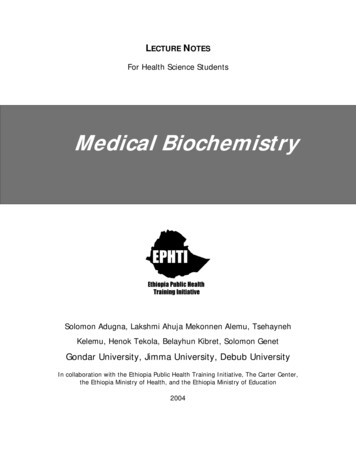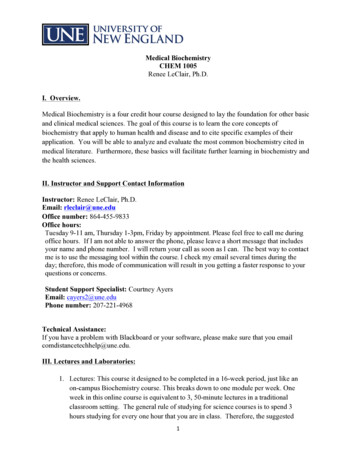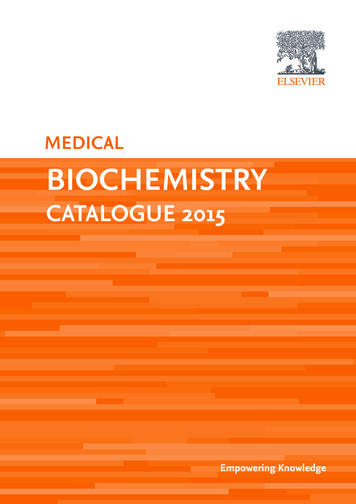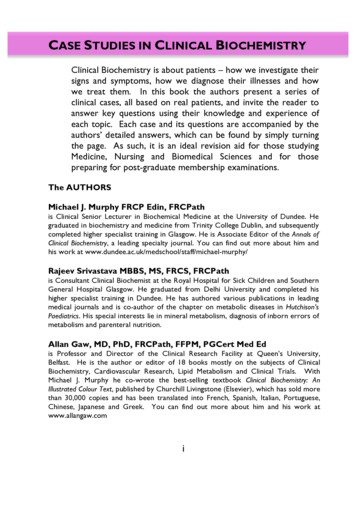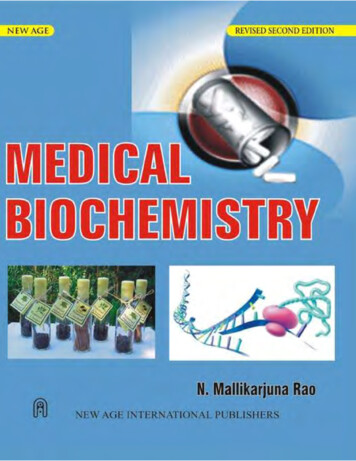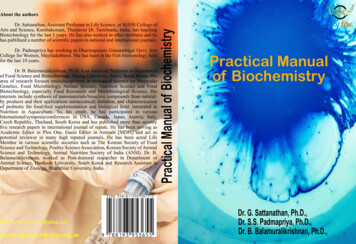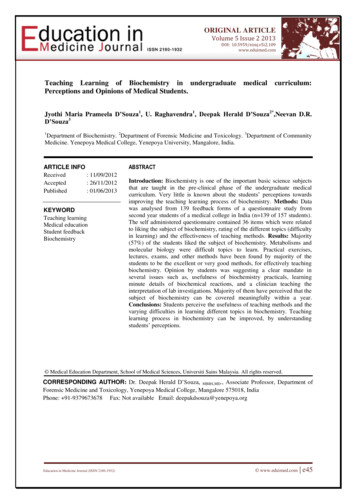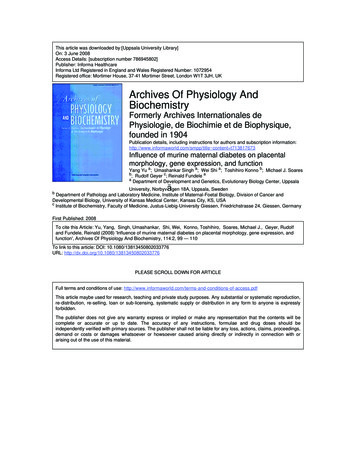
Transcription
This article was downloaded by:[Uppsala University Library]On: 3 June 2008Access Details: [subscription number 786945802]Publisher: Informa HealthcareInforma Ltd Registered in England and Wales Registered Number: 1072954Registered office: Mortimer House, 37-41 Mortimer Street, London W1T 3JH, UKArchives Of Physiology AndBiochemistryFormerly Archives Internationales dePhysiologie, de Biochimie et de Biophysique,founded in 1904Publication details, including instructions for authors and subscription information:http://www.informaworld.com/smpp/title content t713817673Influence of murine maternal diabetes on placentalmorphology, gene expression, and functionYang Yu a; Umashankar Singh a; Wei Shi a; Toshihiro Konno b; Michael J. Soaresb; Rudolf Geyer c; Reinald Fundele aaDepartment of Development and Genetics, Evolutionary Biology Center, UppsalaUniversity, Norbyv gen 18A, Uppsala, SwedenDepartment of Pathology and Laboratory Medicine, Institute of Maternal-Foetal Biology, Division of Cancer andDevelopmental Biology, University of Kansas Medical Center, Kansas City, KS, USAcInstitute of Biochemistry, Faculty of Medicine, Justus-Liebig-University Giessen, Friedrichstrasse 24, Giessen, GermanybFirst Published: 2008To cite this Article: Yu, Yang, Singh, Umashankar, Shi, Wei, Konno, Toshihiro, Soares, Michael J., Geyer, Rudolfand Fundele, Reinald (2008) 'Influence of murine maternal diabetes on placental morphology, gene expression, andfunction', Archives Of Physiology And Biochemistry, 114:2, 99 — 110To link to this article: DOI: 10.1080/13813450802033776URL: http://dx.doi.org/10.1080/13813450802033776PLEASE SCROLL DOWN FOR ARTICLEFull terms and conditions of use: f-access.pdfThis article maybe used for research, teaching and private study purposes. Any substantial or systematic reproduction,re-distribution, re-selling, loan or sub-licensing, systematic supply or distribution in any form to anyone is expresslyforbidden.The publisher does not give any warranty express or implied or make any representation that the contents will becomplete or accurate or up to date. The accuracy of any instructions, formulae and drug doses should beindependently verified with primary sources. The publisher shall not be liable for any loss, actions, claims, proceedings,demand or costs or damages whatsoever or howsoever caused arising directly or indirectly in connection with orarising out of the use of this material.
Downloaded By: [Uppsala University Library] At: 10:42 3 June 2008Archives of Physiology and Biochemistry, April 2008; 114(2): 99 – 110ORIGINAL ARTICLEInfluence of murine maternal diabetes on placental morphology,gene expression, and functionYANG YU1, UMASHANKAR SINGH1, WEI SHI1, TOSHIHIRO KONNO2,MICHAEL J. SOARES2, RUDOLF GEYER3, & REINALD FUNDELE11Department of Development and Genetics, Evolutionary Biology Center, Uppsala University, Norbyvägen 18A, 75236Uppsala, Sweden, 2Department of Pathology and Laboratory Medicine, Institute of Maternal-Foetal Biology, Division ofCancer and Developmental Biology, University of Kansas Medical Center, Kansas City, KS 66160, USA, and 3Institute ofBiochemistry, Faculty of Medicine, Justus-Liebig-University Giessen, Friedrichstrasse 24, 35392 Giessen, GermanyAbstractMaternal diabetes causes placental and foetal abnormalities in both rat and humans; however, its effect is less well documentedin the mouse. We used a standard approach to induce manifest diabetes in pregnant mice and assessed morphology, functionand gene expression in the placentas isolated from these females. We found that diabetic placentas exhibit a consistentabnormal phenotype characterized by increased junctional zone cross sectional area. Lipid profiling of diabetic foetuses andplacentas showed that the placental phenotypes do not compromise the lipid transport function of this organ. In a genomewide survey of mRNA expression by using cDNA micro-arrays, we identified 118 ESTs, corresponding to 59 annotated genes,with differential expression in the diabetic placentas. A significant proportion of these known is involved in metabolism,immunity and defence, and signal transduction. In addition, we found two imprinted genes, Igf2 and Gatm, which exhibitedaltered expression. The expression of other imprinted genes, Peg1, Gtl2, Peg3, Igf2r and Grb10, was determined by quantitativeRT-PCR. For all of these genes, slight changes in gene expression were observed between diabetic placentas and controlplacentas. Our study thus provides the basis for future work that will address gene action in the diabetic mouse placenta.Key words: Mouse placenta, maternal diabetes, morphology, function, gene expression.IntroductionIn humans, maternal diabetes is still a major causefor birth defects and perinatal mortality, eventhough the rate of most other complicationsassociated with diabetes has been strongly reduced(Reece and Homko, 1993; Garner, 1995; Erikssonet al., 2003; Zhao et al., 2005). Thus, the expectedincidence for congenital malformation may be fiveto six times higher in diabetic compared to nondiabetic pregnancy (see Eriksson et al., 2003 andreferences therein). Given the magnitude of theproblem, it is not surprising that embryonic andfoetal development in diabetic pregnancy has beenstudied extensively in both clinical (MølstedPedersen et al., 1964; Ray et al., 2001) andexperimental (Lazarow et al., 1960; Wentzel et al.,2001) studies. In brief, there is conclusive evidencethat hyperglycaemia per se acts as primary teratogen(Styrud et al., 1995; Moley et al., 1998a, 1998b),but that other factors, such as inositol depletion(Baker et al., 1990), alterations of arachidonic acid(Goldman et al., 1985), and oxidative stress(Baynes, 1991) are also causative in abnormalembryonic and foetal development. Especially thesustained production of reactive oxygen species(ROS) caused by maternal hyperglycaemia seemsto be a major additional teratogenic factor, astreatment with antioxidants, such as vitamins Eand C, or addition of scavenging enzymes such assuperoxide dismutase, catalase, or glutathione peroxidase, to embryo culture media reduce embryonicmalformations in the diabetic rat model (reviewedin Eriksson et al., 2003).Maternal diabetes is known to target not onlyfoetal but also placental development in humans(Casson et al., 1997; Evers et al., 2000; Evers et al.,2003). Frequent placental abnormalities associatedCorrespondence: Reinald Fundele, Department of Development and Genetics, Evolutionary Biology Center, Uppsala University, Norbyvägen 18A, 75236Uppsala, Sweden. E-mail: reinald.fundele@ebc.uu.seReceived for publication 27 June 2007. Accepted 13 December 2007.ISSN 1381-3455 print/ISSN 1744-4160 online ª 2008 Informa UK Ltd.DOI: 10.1080/13813450802033776
Downloaded By: [Uppsala University Library] At: 10:42 3 June 2008100Y. Yu et al.with maternal diabetes are chorangiosis and increased presence of nucleated foetal red blood cells,a sign of chronic foetal hypoxia (Fox, 1967; Greenand Mimouni, 1990; Benirschke and Kaufmann,1998). Another frequently observed abnormality isplacental immaturity and extensive villous immaturity coupled with compromised function due toincreased diffusion distance between intervillousspace and foetal capillaries (Laurini et al., 1987),which may ultimately lead to antenatal foetal aspyxiaand foetal death (Fox et al., 1978; Laurini et al.,1987; Greco et al., 1989). Increased placental weightmay be one mechanism to compensate for villousimmaturity and functional deficits (Evers et al.,2003). Abnormally increased placental weight is alsoobserved in a standard animal model of diabetes,streptozotocin (STZ)-induced diabetes in the rat(Gewolb et al., 1986; Padmanabhan and Shafiullah,2001). Like the human diabetic placenta, the ratdiabetic placenta exhibits consistent and specificmorphological alterations, apart from increasedweight. One characteristic feature is a strikinglyincreased abundance of glycogen-containing cells(GlCs) in the decidua basalis, the spongiotrophoblast, and the labyrinth, and of giant cells in thejunctional zone (Padmanabhan and Shafiullah,2001). Interestingly, accumulation of glycogen isalso a feature of the human diabetic placenta (Jonesand Desoye, 1993; Desoye et al., 2002). Furthermore, the spongiotrophoblast layer is thickened inthe diabetic rat placenta as compared to controls. Ofdirect functional relevance is the finding that thetrophoblast layers of the interhemal membrane aresignificantly thicker in diabetic placentas (Gewolbet al., 1986; Padmanabhan and Shafiullah, 2001).Together with the distortion of the labyrinth, causedby ingrowth of spongiotrophoblast pegs, cysticchanges of the spongiotrophoblast, and reducedarborization of the foetal vasculature, this couldcontribute significantly to compromised maternofoetal exchange and thus to foetal growth restriction(Gewolb et al., 1986; Padmanabhan and Shafiullah,2001). Thus, the increased weight of the diabetic ratplacenta, like that of the human diabetic placenta,may again be a compensatory mechanism to alleviate its functional deficits (Gewolb et al., 1986;Padmanabhan and Shafiullah, 2001).Unfortunately, little is known to date about theeffects of gestational diabetes on placental development and function in the mouse, as compared to ratand human. This deficit has become the moredeplorable, as the mouse, due to the facility of genetargeting, has become the standard mammalianmodel to assess gene function. We therefore used astandard method to induce diabetes in pregnant miceand then assayed placental morphology, function andgene expression. Our results show that severediabetes induces mild histological changes in themouse placenta, which however do not seem tointerfere with its transport function. Finally, we haveidentified a considerable number of genes withaltered expression in diabetic placentas, which aretherefore candidate genes for further analysis.Materials and methodsExperimental animalsAll experiments with mice were conducted accordingto the guidelines issued by Uppsala University. Fourmouse strains, selected for availability, were used inour experiment, C57BL/6, BALB/c, DBA/1 and CBA/J (B&K, Stockholm), to rule out the possibility thateffects of gestational diabetic differ between differentmouse strains. Diabetes in female mice was experimentally induced by streptozotocin (STZ, Sigma).After 6 hours of starving, a single dose of STZ(200 mg/kg of body weight) dissolved in sterile salinewas administrated by intraperitoneal injection. Control mice were injected with an equal volume of saline.On days 3 and 7 after injection, blood glucoseconcentration was measured in blood from tail veinusing a glucose meter (Accu-Check Sensor, Roche).Mice with glucose concentration exceeding 11.1mmol/l (200 mg/dl) were regarded as diabetic, withglucose concentrations between 11.1 and 16.7 mmol/l(300 mg/dl) defined as moderate diabetes and concentrations above 16.7 mmol/l defined as severediabetes (Padmanabhan and Shafiullah, 2001). Suchdiabetic female mice were mated either on day 3 or day7, depending on blood glucose concentration, withhealthy males of the same strain. In case of BALB/c andC57BL/6 each, 15 mice were in the diabetic group and5 in the control group. For both DBA/1 and CBA/J, 5females were included in each group. All females werekilled on E18 of gestation [counting the day of thevaginal plug as day 1 (E1) of gestation]. Mice weresacrificed by cervical dislocation and conceptuseswere dissected out. Maternal and foetal blood glucoselevels were determined. For the determination ofplacental and foetal wet weights, conceptuses fromboth moderately and severely diabetic females wereused, however, for all further studies, only foetusesand placentas isolated from females with bloodglucose levels of 16.7 mM were used. Foetusesand placental halves were frozen in liquid nitrogen andstored at 7808C until further processing. For histomorphological study, the other half of the placenta wasfixed in cold Serra’s fixative (60% ethanol, 30%formalin and 10% glacial acetic acid) at 48C overnightand processed for paraffin embedding.Histology and semi-quantitative morphometryFor visual assessment of placentas, hematoxylineosin (HE) and isolectin B4 staining were performedon paraffin-embedded sections (7mm) from placentasof control and diabetic mice. Altogether 80 sectionsfrom 10 control and 27 diabetic placentas were used:from C57BL/6 15 diabetic, four control placentas;
Downloaded By: [Uppsala University Library] At: 10:42 3 June 2008Influence of murine maternal diabetesfrom BALB/c 5 diabetic, two control; from DBA/1 4diabetic, two control; and from CBA/J 3 diabetic, twocontrol. Both male and female placentas were usedfor this analysis. A maximum of two placentas perlitter were selected randomly and in most cases twosections per placenta derived from the midline weremeasured. Isolectin B4 staining was performedas described by Singh et al. (2005). Biotinylatedisolectin B4 and DAB substrate kit were obtainedfrom Vector Labs and Streptavidin-HRP conjugatewas purchased from Perkin Elmer. Semi-quantitativemorphometry on 38 sections stained with isolectinB4 was performed as previously described by Salaset al. (2004) using Adobe Photoshop CS. These 38sections were derived from all different mousestrains and encompassed male and female placentas.Percentage of total section area occupied by thespongiotrophoblast, including the glycogen cells,and labyrinthine layer was calculated. Giant cellsper section were counted on the same 38 sections.Quantification of glycogen cells was performed on20 isolectin B4 stained sections from normal anddiabetic placentas; glycogen cells were identified bytheir characteristic appearance, that is, their translucent cytoplasm and small, densely stained nuclei.10 placentas were selected from each group, usingboth C57BL/6 and DBA/2 genotypes, and onesection per placenta, derived from the midline, wasassessed.RNA extraction, micro-array hybridizationsand data analysisTotal RNA was extracted using Trizol reagent(Invitrogen) according to the manufacturer’s instructions. Two pairs of purified RNA samples, derivedfrom male placentas (Abs 260nm/Abs 280 nm 41.7) (Appendix, Table A1) were used for micro-arraybased expression profiling. Only male placentas wereused to avoid possible sex specific effects of maternaldiabetes on placental development. No pooling ofsamples was performed. Commercially availableMouse 15K (M15K) micro-arrays were obtainedfrom University Health Network (UHN), OntarioCancer Institute, Canada. Detailed informationabout these micro-arrays is available at the followinglink: http://www.microarrays.ca/products/types.html.The TSA-MICROMAX kit (NEN, Perkin Elmer,USA) was used for synthesizing labelled targetcDNA. All steps of the protocol were done accordingto the manufacturer’s instructions with some modifications. The hybridizations were performed usingthe DIG Easy Hyb (Roche). We used 1 mg of Cot1DNA per hybridization. Tween 20 in the TNT bufferwas used at a concentration of 0.1% v/v instead of0.05% v/v described in the kit. Dye swaps for allhybridizations were performed simultaneously. Thelist of expressed sequence tags (ESTs) on the microarray was supplied by the UHN as a clonetracker fileand a Gene Array List (GAL) file was generated101according to the format described for ScanArrayExpress, version 2.1.0. Hybridized and labelledmicro-arrays were scanned immediately after washings using the ScanArray 4000 micro-array scanner(Packard BioChip Technologies) and ScanArrayExpress version 2.1.0 was used for generating theGPR files.The data were stored and analyzed at the microarray data storage and analysis facilities BASE andData Ware House (DWH) respectively, run by theLinnaeus Centre for Bioinformatics (LCB), BMC,Uppsala University, Uppsala, Sweden (detailedinformation at http://www.lcb.uu.se, http://base.lcb.uu.se and http://dw.lcb.uu.se). Briefly, the datain the GPR files was subjected to backgroundsubtraction and within array Print-tip Lowess normalization implemented in R, filtered for differentranges of M values and for occurrences of a reporterin selected number of assays. Signal on control spotswith 3 6 SSC and Arabidopsis DNA were used toremove spots with non-specific hybridization. However, no flags were applied. Significance of variationof expression was calculated for each filteredreporter, by using the B statistics implemented in RBioconductor. The LCB BASE and DWH facilitiescomply with the MIAME guidelines.Quantitative RT-PCR (qRT-PCR)RNA was treated with RNase-free DNase (Promega)and reverse transcribed using M-MLV reversetranscriptase and random primers (Promega) asdescribed previously (Shi et al., 2004a). Primerswere designed using online freeware Primer3. qRTPCR was performed using QuantiTect SYBR greenPCR mix (Qiagen) as described (Shi et al., 2004b).The primers used in qRT-PCR are listed inAppendix, Table A2. PCR conditions were asfollows: initial denaturation 958C for 15 min followedby 40 cycles of 958C for 20 s, 588C for 20 s and 728Cfor 30 s. Melting curve analysis were conductedbetween 658C and 958C. PCR reactions were runon a Rotorgene 3000 (Corbett Research). All sampleswere analysed in duplicate. The ratio of the expression of genes to Actb, many ESTs of which had shownno differential expression between diabetic andnormal placentas in the micro-array hybridization,was calculated by averaging the folds change (calculated by ddCt method) value for each duplicatesample. A minimum PCR efficiency of 1.7 wasconsidered for analysis. Seven sample pairs, allderived from C57BL/6 and including the 2 pairsused in the micro-array hybridizations were used forqRT-PCR. This sample contained 4 male and 3female pairs.In situ hybridizationNon-radioactive in situ hybridization was carried outon the placentas as described (Anson-Cartwright
Downloaded By: [Uppsala University Library] At: 10:42 3 June 2008102Y. Yu et al.et al., 2000). Briefly, in situ probes were generated byusing RT-PCR. These were then cloned intopGEMT Easy vector (Promega). Digoxigenin(Roche) labelled sense and anti-sense riboprobeswere synthesized by in vitro transcription using SP6or T7 RNA polymerases. Sections were hybridizedwith anti-sense or sense probes at 50–538C overnight. After high-stringency washes, sections wereincubated with alkaline phosphatase conjugated antiDigoxigenin antibody (Roche) overnight. Colourreaction was carried out as required for clear staining. Primers used for generating probes were asfollows: Igf2, 50 -CGGGGATCCGAGAGGGACGTGTCTACCTCTC-30 and 50 -CCGGAATTCGAGCTCTTTGGCAAGCATGCGACCCC-30 ; Gatm,50 -ATCCTGATGGTTGTGGGAAA-30 and 50 -GGTCCATCCTGCTTTCTTGA-30 . Sections used forin situ hybridization were derived from 2 maleC57BL/6 placentas.ImmunohistochemistrySections were deparaffinized and incubated withrabbit anti-rat decidual/trophoblast prolactin-relatedprotein (DTPRP) at 1:4000 dilution in phosphatebuffered saline containing 0.1% Triton X-100(Rasmussen et al., 1996; Orwig et al., 1997).Immunolocalization of DTPRP was determinedusing Histostain SP AEC kit (Zymed, South SanFrancisco, CA). Immunostained sections were counterstained with hematoxylin. For DTPRP immunostaining, sections from two diabetic and one controlplacenta, all male, were used.Lipid extraction and analysisTotal lipid was extracted and purified from 16C57BL/6 E18 fetuses and their placentas, eightdiabetic and eight controls, derived from two diabeticand two control pregnancies using methanol/chloroform reagent according to a standardized protocol(Bligh and Dyer, 1959; Wuhrer et al., 2000). Bothdiabetic and control groups contained four males andfour females. Lipids were treated with 500 ml of 1 MHCl and 10 M H2O in methanol for 16 h at 1008Caccording to Gaver and Sweeley (1965). Fatty acids,released as their methyl esters, were recovered by athree-fold phase partition using n-hexane. Fatty acidmethyl esters were analysed by gas chromatography/mass spectrometry using a VF 5ms capillary column(60 m, 0.25 mm inner diameter, 0.1 mm filmthickness; Varian, Darmstadt Germany) and 2.5 ml/min helium as carrier gas. Temperature was maintained at 508C for 2 min, raised to 1308C with 408C/min and to 3008C with 68C/min and was finallymaintained at 3008C for 5 min. Fatty acidcompounds were registered by mass spectrometryin the positive ion mode after chemical ionization with methanol using an PolarisQ instrument(ThermoQuest Analytical Systems).Statistical AnalysisStatistical analysis was carried out by t-test usingGraphPad Prism 3.0 (San Diego, CA). A value ofp 5 0.05 was considered significant. Data are presented as mean SD.ResultsDevelopment of foetuses and placentas of diabeticmouse femalesNo significant difference was observed in litter-sizebetween normal (7.8 4.1, n ¼ 11) and diabetic(7.4 2.3, n ¼ 14) pregnancies (p 4 0.05). Fromthese 25 litters, altogether 182 placentas werecollected, 80 from controls and 102 from diabeticfemales. The latter were further sub-divided into twogroups, originating either from moderately diabeticfemales, with blood glucose levels between 11.1 and16.7 mM (200 and 300 mg/dl), or from highlydiabetic females, with blood glucose levels 16.7 mM(300 mg/dl). As shown in Table I, placental weightswere not significantly reduced at E18 of gestation indiabetic pregnancies. In contrast to this, foetalweights were significantly reduced in highly diabeticfemales, independent of maternal strain (Table II)and foetal sex (data not shown). Foetuses from thesepregnancies also exhibited increased blood glucoselevels (18.4 12.4 mM), when compared to controlpregnancies (0.9 0.2 mM). While there was atendency for reduced foetal weight in moderatelydiabetic pregnancies, this was not significant(Table II). However, higher resorption rates wereobserved in diabetic pregnancies (2.2 0.7/litter) ascompared to normal pregnancies (0.7 0.5/litter).Placental morphologyTo determine if placentas from highly diabeticpregnancies exhibited altered morphology comparedTable I. Placental weights in non-diabetic and diabetic mice.Placenta weight diabetesbBalb/c95.1 8.4(n ¼ 18)114.6 17.4(n ¼ 26)116.2 7.8(n ¼ 13)125.7 7.3(n ¼ 23)98.5 11.3(n ¼ 11)118.4 7.6(n ¼ 18)117.4 13.4(n ¼ 9)126.3 16.5(n ¼ 8)88.2 14.9(n ¼ 9)107.5 22.4(n ¼ 25)104.1 16.3(n ¼ 10)112.6 24.8(n ¼ 12)C57BL/6CBA/JDBA/1Values are given as means SD. Differences between nondiabetic, moderately diabetic and severely diabetic placentas werenot significant. amaternal blood glucose 11.1–16.7 mM; bmaternalblood glucose 4 16.7 mM.
Downloaded By: [Uppsala University Library] At: 10:42 3 June 2008Influence of murine maternal diabeteswith control placentas, paraffin histology wasperformed. Visual analysis of 80 sections from 10control and 27 diabetic placentas suggested thatsevere maternal diabetes in the mouse results inmoderately enlarged spongiotrophoblast and increased numbers of giant cells. This impression wasTable II. Fetal weight in non-diabetic and diabetic mice.MousestrainBalb/cC57BL/6CBA/JDBA/1Control (mg)Moderatediabetes (mg)Severediabetes (mg)852 78.4(n ¼ 18)845 48.3(n ¼ 26)816 68.7(n ¼ 13)856 87.3(n ¼ 23)825 90.3(n ¼ 11)833 39.4(n ¼ 18)799 37.6(n ¼ 9)820 93.1(n ¼ 8)716 41.3a(n ¼ 9)665 54.6b(n ¼ 25)684 42.9a(n ¼ 10)609 29.2c(n ¼ 12)Values are given as means SD. Moderate and severe diabetesdefined as for table I. ap 5 0.05, bp 5 0.005 and cp 5 0.001.103confirmed by semi-quantitative morphometric analysis of 38 isolectin B4 stained sections, whichclearly showed significant spongiotrophoblast enlargement in all diabetic placentas (Figure 1B). Thespongiotrophoblast, including glycogen cells, constituted 20.9 0.5% of the section area of controlplacentas but 28.5 0.9% of the section area ofdiabetic placentas (p 5 0.05). Semi-quantitativemorphometry showed that glycogen cell differentiation was strongly increased in the diabetic placentas,where they formed 16.7 2.1% of section area, ascompared to 7.5 1.3% in control placentas. Indiabetic placentas, but not control placentas, glycogen cells were frequently seen in the labyrinth ofdiabetic placentas (Figure 1D,F; Figure 2G). Inaddition, diabetic placentas had significantly moregiant cells per section, 41.9 6.4, than controlplacentas, 29.4 7.0 (p 5 0.05; Figure 1C–F).Thus, E18 mouse placentas from type I diabeticfemales exhibit some of the phenotypes that wereseen in late-gestation rat placentas from diabeticpregnancies.Figure 1. Morphological analysis of diabetic and control placentas. A, B, C, D, E and F: isolectin B4 staining. A: control placenta. B:diabetic placenta. C and D: spongiotrophoblast layer in control and diabetic placenta. E and F: labyrinth layer in control and diabeticplacenta. Black arrows show glycogen cells, white arrows show giant cells. Scale bar: 1 mm. Dec, decidua; Spt, spongiotrophoblast; Lab,labyrinth.
Y. Yu et al.Downloaded By: [Uppsala University Library] At: 10:42 3 June 2008104Figure 2. Quantitative RT-PCR, ISH and IHC analysis of diabetic and control placentas. A: quatitative RT-PCR. Black bar: gene expressionlevel in control placentas; White bar: gene expression level in diabetic placentas. Gene names and fold changes obtained in the microarrayhybridizations are shown below the X-axis. B and C: Igf2 in situ hybridization in control and diabetic placentas. D and E: Gatm in situhybridization in control and diabetic placentas. F and G: DTPRP immunohistochemistry staining in control and diabetic placentas. Arrowsshow positive signal. Scale bar: 1 mm.Function of placentas from diabetic pregnanciesThe over-representation in diabetic placentas ofspongiotrophoblast at the expense of the labyrinth,which is responsible for nutrient transfer, suggestedthat placental transport functions could be compromised. Thus, one parameter of placental transport
Downloaded By: [Uppsala University Library] At: 10:42 3 June 2008Influence of murine maternal diabeteswas assessed by determining the accumulation of theessential fatty acids (EFAs) linoleic acid (18:2),arachidonic acid (20:4), and docosahexaenoic acid(22:6), and the non-essential fatty acids (NEFAs)palmytic acid (16:0) and stearic acid (18:0). EFAsare obtained through the mother’s diet and aretherefore transported to the foetal organism via theplacenta. NEFAs are synthesized in the foetalorganism. With this approach, compromised placental transport function is indicated by distorted ratiosof EFAs and NEFAs in favour of the latter (Wu et al.,2003). Our lipid measurements provided no evidence for defective lipid transport function ofdiabetic placentas. Thus, in control E18 foetusesthe EFAs made up 31.5 10.0% (N ¼ 8) of all FAs.In diabetic fetuses this value was 29.0 11.9 (N ¼ 8;P ¼ 0.327). In the placentas from the same conceptuses, these values were 20.4 5.1% and17.3 9.8%, for control and diabetic placentas,respectively (P ¼ 0.07). However, this finding doesnot exclude the possibility that other transportsystems are affected in the diabetic placentas.Gene expression in placentas from diabetic femalesExpression profiles of two male placentas each fromseverely diabetic and control E18 C57BL/6 pregnancies were compared by cDNA micro-array hybridization. At thresholds of B value 4 74 (Appendix,Figure A1), 118 ESTs exhibited differential expression consistently in all four hybridizations and also forduplicate spots representing each EST on the microarrays with a minimum fold change of 1.3. Of thesedifferentially expressed ESTs, 28 were up-regulatedand 90 were down-regulated. As inferred from NCBIUniGene and Gene Ontology databases, for 59 ofthese 118 ESTs, no precise functional annotation isavailable. The remaining 59 ESTs represented 10biological process clusters as defined by using http://www.pantherdb.org/. The differentially expressedgenes could be classified into the following majorfunctional groups: metabolism (n ¼ 20), signal transduction (n ¼ 13), and immunity and defence (n ¼ 8).A list of functional categories, accession numbers,and folds changes of all annotated, differentiallyexpressed ESTs is given in Table III. Two imprintedgenes, Igf2 and Gatm were also found deregulated inthe diabetic placentas compared to controls. WhileIgf2 was decreased in expression, Gatm exhibited anincrease in expression. Both of these genes areimplicated in placental growth. Whereas for Igf2 adirect role in placental growth has been proven(Constância et al., 2002), Gatm was found underexpressed in some other models of placental hyperplasia (Singh et al., 2004). For 12 genes, Gatm, Hexb,Rrm2, Insig1, Plac8, Gpx3, Igf2, Txnip, Sh2bpsm1,Sherpinf1, Nr2f2 and Dtprp, micro-array hybridizationresults were controlled by qRT-PCR, and, for Igf2,Gatm, and Dtprp, by in situ hybridisation (ISH) orimmunohistochemistry (IHC) analysis as well. As105only two pairs of E18 diabetic/control placentas hadbeen used for micro-array analysis, an additional fivepairs were used in qRT-PCR. With exception ofPlac8 and Nr2f2, qRT-PCR largely supported theresults of the micro-array hybridizations (Figure 2A).However, for some genes such as Igf2 and Rrm2,fold-change values differed considerably. Downregulation of Igf2, specifically in the labyrinth ofdiabetic placentas and in glycogen cells, was alsoclearly visible by ISH (Figure 2B, C). The fact thatsignal strengths were comparable in yolk sac ofdiabetic and normal placentas demonstrated thatreduced Igf2 expression was specific for the placenta.Gatm up-regulation was also clearly visible by ISH(Figure 2D, E). DTPRP immunostaining intensityalso seemed to be stronger in spongiotrophoblast ofdiabetic than of control placentas (Figure 2G, F),however, the difference was not as strong as with Igf2and Gatm. As imprinted genes are important inplacental development (Coan et al., 2005), relativetranscript levels were determined by qRT-PCR forthe imprinted genes Peg1, Gtl2, Peg3, Igf2r andGrb10, whi
Archives of Physiology and Biochemistry, April 2008; 114(2): 99–110 ISSN 1381-3455 print/ISSN 1744-4160 onl


